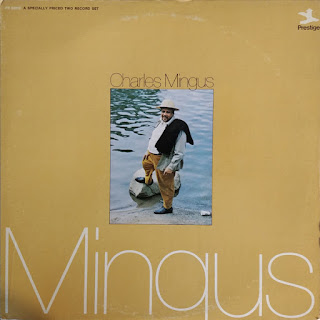Charles Mingus - Mingus (Album Review)
Charles Mingus - Mingus
(1972)
My copy: 1972 stereo compilation by Prestige.
This 1972 double album collects two live shows recorded in 1955 at the Bohemia Cafe in New York (Mingus At The Bohemia and Charles Mingus Quintet & Max Roach). Mingus and his crew tackle a variety of styles here, even inviting famed jazz drummer Max Roach to perform on three songs. While there are many typical passages of smooth jazz, Mingus also delves into free jazz and hard bop, experimenting frequently with dissonance and bluesy compositions.
Mingus’s own iconic method of double-bass playing is integral to his original “Jump Monk” where the bass rattles and bursts, even after the cool, swung drums come to even things out. There are erratic moments to keep the audience on their toes, with the saxophone and trombone melodies almost always acting as mediators to the more chaotic piano and bass. “Serenade In Blue” revels in anguished bass dissonance - unwinding slowly with angst until the tempo picks up, lightening the mood. Max Roach hops on drums for his own “Percussion Discussion” which persists as a rather paranoid piece of free jazz experimentation featuring only brief moments of sanctuary.
The piano becomes a standout addition on “Work Song” where a steady, mysterious jazz groove is offset by dissonant, hostile piano bashing. Motifs are often coined at the start of the track to be revisited again at the end, such as the combo of tense bass and sentimental trombone on “Septemberly.” “All Things You Can (C Sharp)” features one of the better melodic motifs in its sassy, dynamic melodies that lash out from the saxophone. Fans of more traditional jazz can rest assured as there are plenty of solos to be had in the mid section of most songs, with the piano often stealing the show here in the second half.
The solemn trod of “A Foggy Day” is frequently interrupted by a deflating trombone that hangs overhead like gloomy clouds. “Drums” is another experimental collaboration for Roach and Mingus, this time more openly embracing dark progressions, and cleverly playing with silence and anticipation. “Haitian Fight Song” and “Ladybird” are fairly straightforward though the latter impresses more by frequently switching between soft breathiness and loud honking. The longest track is their rendition of “I’ll Remember April,” featuring Roach on drums one final time. Given that “I’ll Remember April” is not a Roach/Mingus original, the structure is more easily digested, with trading solos that again showcase genius piano renditions - at the core, however, is Roach’s extended drum solo and polyrhythmic excursions, which firmly showcase his pure talent.
“Love Chant” basks in a gaggle of intricate melodies, as they occasionally overlap before closing out the record. Charles Mingus’s bass form is not to be understated either, with many of his own solos branching out into new, insanely creative territory for 1955. Mingus is a long, and at times, challenging collection of tunes - but it rewards patience with genius performances. While it’s easy for some of the smoother moments to fade into the background, Mingus and Roach ensure their starkly modern machinations break up the pacing in all the right places. The record also sounds amazing for a live album.




Comments
Post a Comment